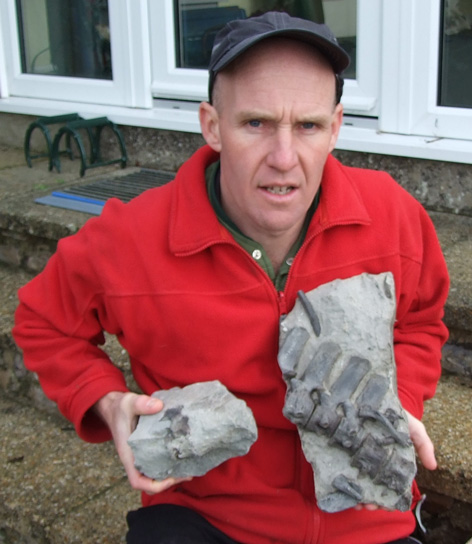His and Her Trilobites – Beautiful Fossils
Dorset Fossil Expert Sends Everything Dinosaur Trilobites
For Brandon Lennon, fossil expert and ammonite polisher supreme, this time of year is very busy as he prepares for the public Lyme Regis fossil walks which start again on Saturday 14th February. February 2015, may seem a long way off, but for someone who spends his time studying the extensive fossil beds on this part of Dorset coast, it is merely a blink in geological time away. Over the winter months, Brandon will be examining tide tables, looking at where rock falls and mud slides occur and plotting the best walks for those members of the public lucky enough to join him on his fossil finding adventures.
Fossil Hunting During the Winter
Brandon Lennon – Looking Forward to More Fossil Collecting in 2015
Plesiosaur Vertebrae
The picture above shows Brandon, with some beautifully preserved vertebrae from a Plesiosaurus, a marine reptile, fossils of which can be found eroding out of the cliffs on some parts of the Dorset coast. Next year, marks the 200th anniversary of the publication of the world’s first extensive geological map. The map that plotted the geology of England, Wales and parts of Scotland was created by the surveyor William Smith, (1769-1839), nick-named “strata Smith”, as it was Smith who used knowledge about which types of fossils could be found in which types of rock to plot the depositional sequence of strata.
The Geology of the Dorset Coast
This map, with its catchy title “A Delineation of the Strata of England and Wales with part of Scotland*“, is regarded by many scientists and cartographers as one of the most important and significant maps ever created, it has even been dubbed “the map that changed the world”. The geology of the Dorset coast is included, it forms one of fifteen sections that when combined produce the geological map. Brandon and his father (a retired geologist), would be able to recognise the underlying geology as identified by Smith all those years ago.
Being able to identify the best places to look when it comes to finding fossils is a key skill for a leader of guided fossil walks and Brandon has more than twenty years experience in the role.
For further information on Guided Fossil Walks in the Lyme Regis area: Lyme Regis Fossil Walks.
Trilobite Fossils
Brandon’s extensive interests are not confined to Jurassic aged sediments. The other day, he kindly sent Everything Dinosaur a couple of trilobite specimens to add to our arthropod fossil collection. Most vertebrate palaeontologists, when quizzed, will openly admit to having a passion for all things Trilobita. These entirely marine relatives of crustaceans, insects and spiders, evolved during the Cambrian and survived right up to the End Permian mass extinction event.
Trilobites come in all shapes and sizes and the two specimens sent to us by Brandon are fine examples of the genus Calymene (the genus name means “beautiful crescent” and it is pronounced kal-im-minny). These particular fossils probably come from Morocco and date from the Late Ordovician, making them approximately 270 million years older than the strata explored by Brandon and the groups he takes out on his fossil walks.
We have nick-named the trilobites “Mike and Sue”.
Trilobite Fossils Sent to Everything Dinosaur by Brandon Lennon
Picture credit: Everything Dinosaur
To read more about Brandon’s fossil hunting adventures including an article on ammonite polishing: Fossil Experts Demonstrate Their Skills.
*In Georgian times, in nascent scientific circles, there was a trend to give extremely long titles to publications. It seems a case of don’t use one word when five words would do instead. The full title of the 1815 geological survey map is:
“A Delineation of the Strata of England and Wales with part of Scotland, exhibiting the collieries and mines, the marshes and fen lands originally overflowed by the sea, and the varieties of soil according to the variations in the substrata, illustrated by the most descriptive names by W. Smith.”
Visit Everything Dinosaur’s award-winning website: Everything Dinosaur.



